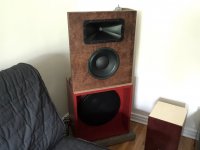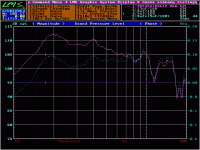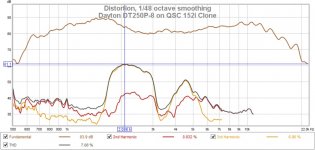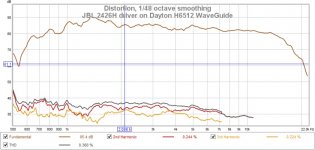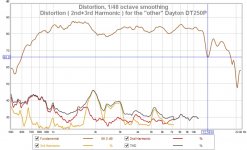Hello all!
Dayton Audio DT250P-8 1" Polyimide Compression Horn Driver 1-3/8"-18 TPI 8 Ohm
plus
Dayton Audio H6512 6-1/2" x 12" Waveguide 1-3/8"- 18 TPI
plus
Eminence PXB2:1K6 2-Way Speaker Crossover Board 1,600 Hz
At first I thought it sounded too dull. Then I listened for a couple of hours. The more I listened the more I liked. This tweeter has barely any sibilance (nothing objectionable at all). Horns blare, vocals (both male and female) soar, strings sing. I really like it. Now I have to work on the mid/woofer. Currently an Eminence Beta 10A (originally I was going to put these components into a ported box but decide to go OB). I’m going to buy the Lil’ Buddy (same hole) and see how that works on OB.
The way it is now is actually pretty darn good (sitting on top of powered Alpha 15 H-frames) but I’m hoping for a bit more finesse thru the mids - currently a bit rougher than I like.
The only other compression tweeter I’ve heard is the Eminence ASD 1001 (which has a tick tick tick sound that I believe is attributable to titanium).
Dayton Audio DT250P-8 1" Polyimide Compression Horn Driver 1-3/8"-18 TPI 8 Ohm
plus
Dayton Audio H6512 6-1/2" x 12" Waveguide 1-3/8"- 18 TPI
plus
Eminence PXB2:1K6 2-Way Speaker Crossover Board 1,600 Hz
At first I thought it sounded too dull. Then I listened for a couple of hours. The more I listened the more I liked. This tweeter has barely any sibilance (nothing objectionable at all). Horns blare, vocals (both male and female) soar, strings sing. I really like it. Now I have to work on the mid/woofer. Currently an Eminence Beta 10A (originally I was going to put these components into a ported box but decide to go OB). I’m going to buy the Lil’ Buddy (same hole) and see how that works on OB.
The way it is now is actually pretty darn good (sitting on top of powered Alpha 15 H-frames) but I’m hoping for a bit more finesse thru the mids - currently a bit rougher than I like.
The only other compression tweeter I’ve heard is the Eminence ASD 1001 (which has a tick tick tick sound that I believe is attributable to titanium).
Attachments
I use the polymide version on a K-tube with Delta Pro 8a in a little K-coupler -currently with Eminence's old/generic "3K5" network (which usually is closed to 2K8 - it works well enough in my situation)
listen with headphones (preferably) https://www.youtube.com/watch?v=T71pRwTGfuc
if your waveguide is ~ constant directivity, you'll have to do some R bypassed by C contouring on the pad to get the high end right. Pi speakers, etc. would give guides.
the 1K6 network works with some woofers - sometimes it lets the woofer go too high and peak
maybe Partsexpress will drop the price down to $39.95 again during the upcoming holidays (?) - its a nice driver and in my application as good as or better than B&C DE250 and maybe (?) better than vintage 806 Altec, P-Audio, Selenium, B52
for higher xover, I prefer a K-tube to CD waveguide - vertical pattern matches my K-couplers better. I use Ks as need big front-load horn dynamics in a small package
listen with headphones (preferably) https://www.youtube.com/watch?v=T71pRwTGfuc
if your waveguide is ~ constant directivity, you'll have to do some R bypassed by C contouring on the pad to get the high end right. Pi speakers, etc. would give guides.
the 1K6 network works with some woofers - sometimes it lets the woofer go too high and peak
maybe Partsexpress will drop the price down to $39.95 again during the upcoming holidays (?) - its a nice driver and in my application as good as or better than B&C DE250 and maybe (?) better than vintage 806 Altec, P-Audio, Selenium, B52
for higher xover, I prefer a K-tube to CD waveguide - vertical pattern matches my K-couplers better. I use Ks as need big front-load horn dynamics in a small package
Last edited:
Thanks for your comments guys! To keep things simple I'm just using the pre-built Eminence crossover at 1600kHz.
Eminence PXB2:1K6 2-Way Speaker Crossover Board 1,600 Hz
Crossovers are not my strong suit. It appears the sound is already good. Anyone have any comments on the Lil' Buddy on open baffle before I make the purchase?
Eminence PXB2:1K6 2-Way Speaker Crossover Board 1,600 Hz
Crossovers are not my strong suit. It appears the sound is already good. Anyone have any comments on the Lil' Buddy on open baffle before I make the purchase?
hey bwaslo and 'zilla - that 1K6 Eminence has NO HF compensation for CD waveguides - its a 3rd order highpass, 8uF/22uF and an unidentified air-core inductor - maybe 0.6mH?
constant directivity waveguide response without compensation will drop-off, roughly following driver power response, while old-school horns have on-axis "acoustic eq" from long necks and slow initial expansion (meaning they get dull off axis) A K-tube has some beaming in the top octave, very little width, so will self-EQ in most instances.
you might get it right with one resistor and one cap - ask Wayne over at PI
constant directivity waveguide response without compensation will drop-off, roughly following driver power response, while old-school horns have on-axis "acoustic eq" from long necks and slow initial expansion (meaning they get dull off axis) A K-tube has some beaming in the top octave, very little width, so will self-EQ in most instances.
you might get it right with one resistor and one cap - ask Wayne over at PI
oh because the overhyped seos drops like a rock? this waveguide dont require positive EQ in the high end, as its been shown in countless measurements with d220 and de250 over the years.(Constant directivity waveguides and compression drivers have a naturally drooping high-frequency response).
check Paul`s for example:
Gainphile: S15 - Econowave DSP
the JBL M2 has loads of progressively increasing EQ, but when the D2 driver is switched to a different driver like the 2450-H, only half is necessary!
so dont just assume it needs EQ because CD.
Last edited:
The little 1" Peerless driver that Parts Express sells for 40 dollars is really a great value too.
Its already discontinued!
oh because the overhyped seos drops like a rock? this waveguide dont require positive EQ in the high end, as its been shown in countless measurements with d220 and de250 over the years.
check Paul`s for example:
Gainphile: S15 - Econowave DSP
So, by what mechanism do you suppose the SEOS causes HF to "drop like a rock"? Is there invisible absorbent in the throat that no one can see? Or are there magic substances sucking the pressure waves out of the air?
The SEOS, like all constant directivity waveguides, will have essentially the same response as the driver, which because of diaphragm mass (and the laws of physics) will drop off starting usually around 3kHz. Look at the plane wave response of a driver, that is essentially the same response shape you'll get at the high end with a constant directivity waveguide. Some horns won't drop like that at HF. Because those horns BEAM. Otherwise, they must be coming up with output that the drivers don't have.
hey Zilla - here's your network - wired to my old K18 with 18 inch woofer - teh highpass is feeding a compression driver (can't remember the driver) which sits in the rear chamber . The driver fires through a hole in the lower section of the reflector panel and that feeds a 1.875" by 7.25" K-tube (precise clone of one of Karlson's X15 systems with concentric angled "pre-waveguide" LoL- other X15 had smaller diameter tube)
wires are twisted with some magical thinking/hope they don't fall loose or short
its playing soprano voice and harp
https://youtu.be/XYsdJZA7coE
you need to compensate your network - Wayne at Pi knows all that stuff
wires are twisted with some magical thinking/hope they don't fall loose or short
its playing soprano voice and harp
https://youtu.be/XYsdJZA7coE
you need to compensate your network - Wayne at Pi knows all that stuff
Uhg, does this thing really need additional 'compensation'? Without having to take it all apart can caps, coils or resistors be added to make the mods?
Honestly, I like the way it sounds as is. Certainly doesn't sound bright.
Eminence PXB2:1K6 2-Way Speaker Crossover Board 1,600 Hz
The FR for the cd doesn't show a droop like some others do. One of the reasons I selected this driver was for its flat response.
http://www.parts-express.com/pedocs/specs/270-406--d250p-8.pdf
Freddi, your clip sounds great!
Honestly, I like the way it sounds as is. Certainly doesn't sound bright.
Eminence PXB2:1K6 2-Way Speaker Crossover Board 1,600 Hz
The FR for the cd doesn't show a droop like some others do. One of the reasons I selected this driver was for its flat response.
http://www.parts-express.com/pedocs/specs/270-406--d250p-8.pdf
Freddi, your clip sounds great!
It's not driver responce flatnessOne of the reasons I selected this driver was for its flat response.
http://www.parts-express.com/pedocs/specs/270-406--d250p-8.pdf
http://www.parts-express.com/dayton-audio-h812-1-exponential-horn-100x60-2-bolt--270-304datasheet said:Note: Frequency response measured using Dayton Audio H812 horn..
I think dozens of manufacturers made this really ubiquitous horn))
Last edited:
Godzilla said:Uhg, does this thing really need additional 'compensation'? Without having to take it all apart can caps, coils or resistors be added to make the mods?
Honestly, I like the way it sounds as is. Certainly doesn't sound bright.
<<< SNIP >>>
Hi "G",
You can restore a bit of Top-End ( HF-compensation ) to the horn driver by simply wiring a ( 2uF to 6uF ) capacitor across ( connecting ) pins 3 & 2 of that variable Lpad ( that I see hiding in your pic ).
- You'll need to tweak the cap value to taste since increasing the value starts to allow more & more midrange frequencies in to the bypass circuit ( plus, the position of where you have adjusted the Lpad makes a considerable difference to the needed HF "bypass" cap value.
This advice assumes the Lpad is wired normally & located between the output of the HF portion of the crossover & the HF driver.
An impedance correction circuit ( Zobel ) across the woofer would help insure that the LF portion of your network is behaving as was designed by Eminence ( ie; simplistically, for a constant 7 to 8 ohm impedance ).
Something like a 7.5R ( 10watt ) resistor ( in series ) with a 10uF capacitor, ( & this combo ) wired across ( in parallel with ) the terminals of the woofer, should help immensely.
I'd suggest implementing both of these tweaks before spending more money on other horns or woofers.
PS; - One can simply add ( parallel ) multiple caps together to achieve a larger values / meaning, you could buy multiple values of 1.5uF & 2uF values to create many possible combos.
Uhg, does this thing really need additional 'compensation'? Without having to take it all apart can caps, coils or resistors be added to make the mods?
Honestly, I like the way it sounds as is. Certainly doesn't sound bright.
Eminence PXB2:1K6 2-Way Speaker Crossover Board 1,600 Hz
Here is some advice from my experience doing many things like you are doing now...
I would strongly recommend buying a Umik-1 or something like this https://www.amazon.com/dp/B00ADR2E68/ref=cm_sw_r_cp_api_ake1xbCD5B30P
Download REW for free and do some measurements for yourself. W/o some actual measurements you have no way to truly evaluate your speakers, only other less optimal way than measuring would be to compare this speaker to dozens of others, which still is by no means exact.
Saying "it sounds great to me" is the worst way to evaluate a speaker's accuracy or ability to play across the frequency spectrum.
Manufacturer published response curves are not accurate compared to an actual measurement, they are really only useful for initial evaluation of driver choice, but always to ensure a result you need to do real measurements.
Then with measurements and adjustments you can use your subjective listening opinions to get the best final result of what you like to hear.
Also the off the shelf xo you are using will give a listenable result but by no means optimal, for a horn like this you'll need an L-pad circuit to balance the output of the horn to the woofer, as well as notch circuits to flatten the response as typically you'll find the CD has 5-10db higher output up to 5khz then at 10-20khz.
Consider buying a 2-way miniDSP, this not only gives you very adjustable digital xo but also DSP to smother the response, also great for experimenting too.
HTH!
Javad
Many thanks freddi, Flaesh, EarlK and JShadzi! I will continue to experiment. I'm certainly a fish out of water when it comes to pro sound components but I sure am enjoying them as an alternative to the usual 'home' brands I've tried over the years.
I purchased the Dayton exponential horn out of curiosity. It's similar in size and shape to the Dayton constant directivity horn. I didn't even know there was a difference? I wonder if the exponential will have that 'tunnel' sound some horns exhibit since it's got a longer throat? The one which sounds best to me will get the most attention as I continue to learn.
Meanwhile, the Dayton DT250P plus Dayton H6512 doesn't disappoint! It reveals a lot of texture and is very easy on the ears.
The mid/bass driver (Eminence Beta 10B) sounds a little thick thru the midrange and sometimes even garbled at higher volumes. I'm guessing it's upper frequency limits/breakups may be playing a role. I've ordered a Lil' Buddy which fits the same hole and will give it a listen in the coming days.
I'm an open baffle advocate in search of a pleasant sound.
I purchased the Dayton exponential horn out of curiosity. It's similar in size and shape to the Dayton constant directivity horn. I didn't even know there was a difference? I wonder if the exponential will have that 'tunnel' sound some horns exhibit since it's got a longer throat? The one which sounds best to me will get the most attention as I continue to learn.
Meanwhile, the Dayton DT250P plus Dayton H6512 doesn't disappoint! It reveals a lot of texture and is very easy on the ears.
The mid/bass driver (Eminence Beta 10B) sounds a little thick thru the midrange and sometimes even garbled at higher volumes. I'm guessing it's upper frequency limits/breakups may be playing a role. I've ordered a Lil' Buddy which fits the same hole and will give it a listen in the coming days.
I'm an open baffle advocate in search of a pleasant sound.
.. It's similar in size and shape ..
They are significant different in shape and FR
This looks like a nice driver. A lot of manufacturers seem to be after the DE250 design...it should speak a lot for the DE250.
Which translates into; Buy the original product that everyone wants to copy.
I took a chance and bought a pair of Daytons ( purchased from Solen, here in Canada ).
- I do hope to return them ( with their co-operation ).
Here's the distortion spec for the worst performing driver;
Obviously ( at least to me ), this driver is quite sick and not performing up to a professional spec. ( though maybe it's good enough for the consumer who doesn't measure anything ) .
The following shows a healthy driver ( distortion-wise, under similar test conditions, though with a different waveguide ) ;
The other Dayton driver doesn't fare that much better ( re; 3rd Harmonic distortion at @ 2K, is about 1.6% ).
- This driver was measured on the H6512 waveguide.
The notch at 12.6K is caused by ( I think ) the Dayton driver being unable to fully thread into this waveguide's 1 3/8" receptacle ( Dayton made the plastic threading, too tight ).
- This same driver on the QSC 152i clone doesn't show the 12.6K notch / & neither does the JBL ( which I was able to force fully into the H6512 horn ).
I believe the high distortion specs ( for both drivers ) are caused by the voice-coil binding ( touching ) the gap of the drivers.
( If true) this might also be the cause of the hollowed out response of the FR ( from 2K to 6K ).
- I can understand how the "hollowing-out" could actually be attractive ( as a feature ) to those in the HiFi world who can't design their own networks ( ie; it's much like a built-in BBC hi-mid dip ).
Attachments
Last edited:
- Status
- This old topic is closed. If you want to reopen this topic, contact a moderator using the "Report Post" button.
- Home
- Loudspeakers
- Multi-Way
- Dayton DT250P-8 compression tweeter sings
